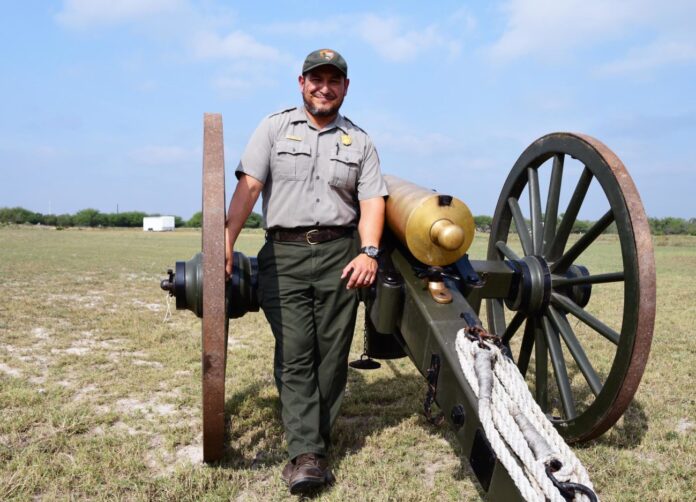BROWNSVILLE — The sharp tang of gunpowder will again drift over the northern part of this city today during a Living History reenactment of the Battle of Palo Alto at the national historical park.
The fight between U.S. and Mexican troops occurred on May 8, 1846, will be re-enacted at Palo Alto Battlefield National Historical Park by volunteers dressed in period uniforms and firing 19th Century muskets and cannon.
The event, free to the public, begins at 10 a.m. and will last until 1 p.m.
Although safety measures are strict to prevent the reoccurrence of any real bloodshed, the re-enactors take their roles quite seriously.
“They really do,” Park Ranger Daniel Ibarra said Friday. “As a park, what we do is kind of help foster that. I wouldn’t call it a hobby — it’s a little bit more than a hobby.
“We have a cache of uniforms, say, if somebody’s interested to become a prospective member of our group and they want to try it out and aren’t exactly sure about it. … But it can be kind of expensive to get started so we have kits that we can loan out to people. The majority of our core group, that’s how they started, they started with the park kit.”
History underfoot
The Battle of Palo Alto and the succeeding fight at Resaca de la Palma were victories for the U.S. forces under the command of Gen. Zachary Taylor, later to become a U.S. president.
Today onlookers will have the chance to walk the same prairie battlefield as Taylor, Lt. Ulysses S. Grant (later a general who commanded Union forces during the Civil War, and a U.S. president himself), Lt. Braxton Bragg (a Confederate general during the Civil War), Maj. Samuel Ringgold (killed by a cannonball at Palo Alto, and memorialized by Fort Ringgold in Rio Grande City) and Capt. Leander McNelly (an eventual Confederate officer and famous Texas Ranger).
“We’re kind of in history season right now, December on through February is the biggest season,” Ibarra said, noting temperatures Saturday are forecast to be in the 70s for the reenactment.
“The guys will appreciate the morning, decked out in wool,” he said.
Kitted out
Uniforms for U.S. Civil War re-enactors are a lot easier to come by than period clothing for the U.S.-Mexican War, Ibarra said.
“You can find a lot more off-the-rack type stuff for the Civil War, that’s a lot easier to come across versus ours,” he said. “For the Mexican army, you almost exclusively have to go to tailor-made items. Not surprisingly, there aren’t too many people out there who are doing the Mexican War-era uniforms.
“If you look in the visitors’ center, it’s very French,” he added of the Mexican infantry uniforms. “If you’ve got a contact who does 19th Century French military, all you have to do is alter some of the colors or the piping or the cuffs or what have you. For our time period here you’re doing Mexican infantry with tailcoats, either canvas or linen pants in white or off-white, or full wool uniforms.”
Cannons of war
Another difference is weaponry, with U.S. forces using more modern cannon and muskets than were available to their Mexican opponents.
“As for the replica weapons we use, we try to be as on-point as possible,” Ibarra said.
Replicas they may be, but they still go bang and, in the case of the cannons, boom. Both sounds are on the menu for the re-enactment Saturday.
“This is the thing people come to see,” he said with a chuckle, patting the barrel of a U.S. six-pounder. “It’s always kind of fun to watch the reaction of the people who haven’t seen the cannon being fired yet. They’re always a bit shocked.”
The 1841 replica U.S. six-pounder cannon was built to exact specifications of the ones used at Palo Alto in 1846.
“Today it doesn’t look like much, it’s essentially a big tube on wheels, that’s all it is,” he noted. “But in 1846 this is the latest smart phone, this is the unmanned drone, this is some of the most advanced technology, period, in contrast to what the Mexican Army had to deal with in their artillery.”
The Mexican cannon used in the battle, eight-pounders, were at least 70 years old then and were far heavier and less maneuverable on the battlefield than the U.S. artillery. Many historians believe that was a key factor favoring U.S. troops in the field in 1846.
“It’s kind of difficult to ask somebody to fight with an antiquated piece of equipment,” he said.
IF YOU GO
WHAT — Reenactment of the Battle of Palo Alto
WHERE — Palo Alto Battlefield National Historical Park. 7200 Paredes Line Road, Brownsville
WHEN — Today, 10 a.m. to 1 p.m.
COST — Free




